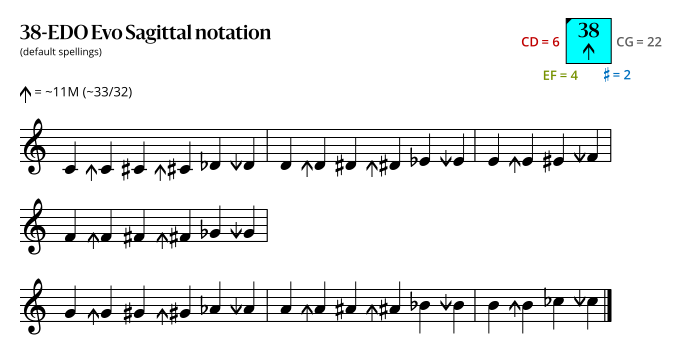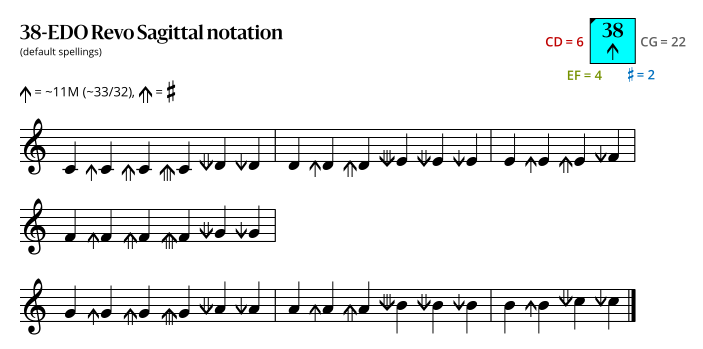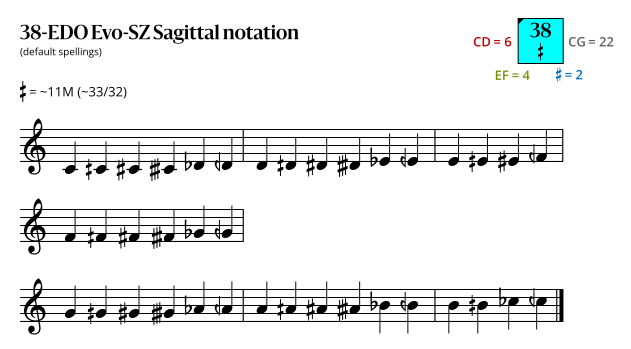38edo: Difference between revisions
Contribution (talk | contribs) No edit summary |
ArrowHead294 (talk | contribs) m Formatting |
||
| Line 5: | Line 5: | ||
Since {{nowrap|38 {{=}} 2 × 19}}, it can be thought of as two parallel [[19edo]]s. While the halving of the step size lowers [[consistency]] and leaves it only mediocre in terms of overall [[relative interval error|relative error]], the fact that the 3rd & 5th harmonics are flat by almost exactly the same amount, while the 11th is double that means there are quite a few near perfect composite ratios, such as the the [[6/5]] it shares with 19edo, plus [[11/9]], [[15/11]] & [[25/22]], (and their inversions) while a single step nears [[55/54]]; the approximation to [[11/9]] in particular should be noted for forming a 10-strong [[consistent circle]]. This gives several interesting possibilities for unusual near-just chords such as 15:18:22:25:30. It [[tempering out|tempers out]] the same [[5-limit]] commas as 19edo, namely [[81/80]], [[3125/3072]] and [[15625/15552]]. In the [[7-limit]], we can add [[50/49]], and tempering out 81/80 and 50/49 gives [[injera]] temperament, for which 38 is the [[optimal patent val]]. In the [[11-limit]], we can add 121/120 and 176/175. | Since {{nowrap|38 {{=}} 2 × 19}}, it can be thought of as two parallel [[19edo]]s. While the halving of the step size lowers [[consistency]] and leaves it only mediocre in terms of overall [[relative interval error|relative error]], the fact that the 3rd & 5th harmonics are flat by almost exactly the same amount, while the 11th is double that means there are quite a few near perfect composite ratios, such as the the [[6/5]] it shares with 19edo, plus [[11/9]], [[15/11]] & [[25/22]], (and their inversions) while a single step nears [[55/54]]; the approximation to [[11/9]] in particular should be noted for forming a 10-strong [[consistent circle]]. This gives several interesting possibilities for unusual near-just chords such as 15:18:22:25:30. It [[tempering out|tempers out]] the same [[5-limit]] commas as 19edo, namely [[81/80]], [[3125/3072]] and [[15625/15552]]. In the [[7-limit]], we can add [[50/49]], and tempering out 81/80 and 50/49 gives [[injera]] temperament, for which 38 is the [[optimal patent val]]. In the [[11-limit]], we can add 121/120 and 176/175. | ||
Using the [[Warts|38df]] mapping, every [[prime interval]] from 3 to 19 is characterized by a flat intonation. Furthermore, the [[mapping]] of all [[19-odd-limit]] intervals in 38df aligns with their closest approximations in 38edo, excepting for 7/4 and 13/8, along with their octave complements 8/7 and 16/13, which are by definition mapped to their secondary optimal steps within 38df. In other words, all 19-odd-limit intervals are [[consistency|consistent]] within the 38df [[val]] {{val| 38 60 88 106 131 140 155 161 }}. | |||
The harmonic series from 1 to 20 is approximated within 38df by the sequence: {{nowrap| 38 22 16 12 10 8 8 6 6 5 5 4 4 4 4 3 3 3 3 }} | The harmonic series from 1 to 20 is approximated within 38df by the sequence: {{nowrap| 38 22 16 12 10 8 8 6 6 5 5 4 4 4 4 3 3 3 3 }} | ||
| Line 298: | Line 298: | ||
== Zeta properties == | == Zeta properties == | ||
===Zeta peak index=== | === Zeta peak index === | ||
{| class="wikitable" | {| class="wikitable" | ||
|- | |- | ||
! | ! colspan="3" | Tuning | ||
! | ! colspan="3" | Strength | ||
! colspan="2" | Closest EDO | |||
! colspan="2" | Integer limit | |||
!EDO | |||
! | |||
|- | |- | ||
|[[166zpi]] | ! ZPI | ||
|37.8901105027757 | ! Steps per octave | ||
|31.6705331305933 | ! Step size (cents) | ||
|5.808723 | ! Height | ||
|0.986660 | ! Integral | ||
|15.046792 | ! Gap | ||
|38edo | ! EDO | ||
|1203.48025896255 | ! Octave (cents) | ||
|6 | ! Consistent | ||
|6 | ! Distinct | ||
|- | |||
| [[166zpi]] | |||
| 37.8901105027757 | |||
| 31.6705331305933 | |||
| 5.808723 | |||
| 0.986660 | |||
| 15.046792 | |||
| 38edo | |||
| 1203.48025896255 | |||
| 6 | |||
| 6 | |||
|} | |} | ||
== Notation == | == Notation == | ||
===Sagittal notation=== | === Sagittal notation === | ||
This notation uses the same sagittal sequence as EDOs [[17edo#Sagittal notation|17]], [[24edo#Sagittal notation|24]], and [[31edo#Sagittal notation|31]], is a subset of the notation for [[76edo#Sagittal notation|76-EDO]], and is a superset of the notation for [[19edo#Sagittal notation|19-EDO]]. | This notation uses the same sagittal sequence as EDOs [[17edo#Sagittal notation|17]], [[24edo#Sagittal notation|24]], and [[31edo#Sagittal notation|31]], is a subset of the notation for [[76edo#Sagittal notation|76-EDO]], and is a superset of the notation for [[19edo#Sagittal notation|19-EDO]]. | ||
==== Evo flavor ==== | |||
<imagemap> | <imagemap> | ||
File:38-EDO_Evo_Sagittal.svg | File:38-EDO_Evo_Sagittal.svg | ||
| Line 341: | Line 343: | ||
</imagemap> | </imagemap> | ||
====Revo flavor==== | ==== Revo flavor ==== | ||
<imagemap> | <imagemap> | ||
File:38-EDO_Revo_Sagittal.svg | File:38-EDO_Revo_Sagittal.svg | ||
| Line 352: | Line 353: | ||
</imagemap> | </imagemap> | ||
====Evo-SZ flavor==== | ==== Evo-SZ flavor ==== | ||
<imagemap> | <imagemap> | ||
File:38-EDO_Evo-SZ_Sagittal.svg | File:38-EDO_Evo-SZ_Sagittal.svg | ||
Revision as of 01:47, 19 January 2025
| ← 37edo | 38edo | 39edo → |
Theory
Since 38 = 2 × 19, it can be thought of as two parallel 19edos. While the halving of the step size lowers consistency and leaves it only mediocre in terms of overall relative error, the fact that the 3rd & 5th harmonics are flat by almost exactly the same amount, while the 11th is double that means there are quite a few near perfect composite ratios, such as the the 6/5 it shares with 19edo, plus 11/9, 15/11 & 25/22, (and their inversions) while a single step nears 55/54; the approximation to 11/9 in particular should be noted for forming a 10-strong consistent circle. This gives several interesting possibilities for unusual near-just chords such as 15:18:22:25:30. It tempers out the same 5-limit commas as 19edo, namely 81/80, 3125/3072 and 15625/15552. In the 7-limit, we can add 50/49, and tempering out 81/80 and 50/49 gives injera temperament, for which 38 is the optimal patent val. In the 11-limit, we can add 121/120 and 176/175.
Using the 38df mapping, every prime interval from 3 to 19 is characterized by a flat intonation. Furthermore, the mapping of all 19-odd-limit intervals in 38df aligns with their closest approximations in 38edo, excepting for 7/4 and 13/8, along with their octave complements 8/7 and 16/13, which are by definition mapped to their secondary optimal steps within 38df. In other words, all 19-odd-limit intervals are consistent within the 38df val ⟨38 60 88 106 131 140 155 161].
The harmonic series from 1 to 20 is approximated within 38df by the sequence: 38 22 16 12 10 8 8 6 6 5 5 4 4 4 4 3 3 3 3
[Harmonic series 2-20 in 38df]
Prime harmonics
| Harmonic | 2 | 3 | 5 | 7 | 11 | 13 | 17 | 19 | 23 | 29 | 31 | |
|---|---|---|---|---|---|---|---|---|---|---|---|---|
| Error | Absolute (¢) | +0.0 | -7.2 | -7.4 | +10.1 | -14.5 | +12.1 | -10.2 | -13.3 | +3.3 | +12.5 | -8.2 |
| Relative (%) | +0.0 | -22.9 | -23.3 | +32.1 | -45.8 | +38.3 | -32.4 | -42.1 | +10.5 | +39.7 | -25.9 | |
| Steps (reduced) |
38 (0) |
60 (22) |
88 (12) |
107 (31) |
131 (17) |
141 (27) |
155 (3) |
161 (9) |
172 (20) |
185 (33) |
188 (36) | |
Intervals
| Step | Cents | 19-odd-limit ratios, in 38df val |
Ups and downs notation* | ||
|---|---|---|---|---|---|
| 0 | 0.0 | Perfect 1sn | P1 | D | |
| 1 | 31.6 | Up 1sn | ^1 | ^D | |
| 2 | 63.2 | Aug 1sn, dim 2nd | A1, d2 | D# | |
| 3 | 94.7 | 20/19, 19/18, 18/17, 17/16 | Upaug 1sn, downminor 2nd | ^A1, vm2 | ^D#, vEb |
| 4 | 126.3 | 16/15, 15/14, 14/13, 13/12 | Minor 2nd | m2 | Eb |
| 5 | 157.9 | 12/11, 11/10 | Mid 2nd | ~2 | vE |
| 6 | 189.5 | 10/9, 19/17, 9/8 | Major 2nd | M2 | E |
| 7 | 221.1 | 17/15 | Upmajor 2nd | ^M2 | ^E |
| 8 | 252.6 | 8/7, 15/13, 22/19, 7/6 | Aug 2nd, Dim 3rd | A2, d3 | E#, Fb |
| 9 | 284.2 | 20/17, 13/11, 19/16 | Downminor 3rd | vm3 | vF |
| 10 | 315.8 | 6/5 | Minor 3rd | m3 | F |
| 11 | 347.4 | 17/14, 11/9 | Mid 3rd | ~3 | ^F |
| 12 | 378.9 | 16/13, 5/4 | Major 3rd | M3 | F# |
| 13 | 410.5 | 24/19, 19/15, 14/11 | Upmajor 3rd, Downdim 4th | ^M3, vd4 | ^F#, vGb |
| 14 | 442.1 | 9/7, 22/17, 13/10 | Aug 3rd, dim 4th | A3, d4 | Gb |
| 15 | 473.7 | 17/13 | Down 4th | v4 | vG |
| 16 | 505.3 | 4/3 | Perfect 4th | P4 | G |
| 17 | 536.8 | 19/14, 15/11, 26/19, 11/8 | Up 4th | ^4 | ^G |
| 18 | 568.4 | 18/13, 7/5 | Aug 4th | A4 | G# |
| 19 | 600.0 | 24/17, 17/12 | Upaug 4th, downdim 5th | ^A4, vd5 | ^G#, vAb |
| 20 | 631.6 | 10/7, 13/9 | Dim 5th | d5 | Ab |
| 21 | 663.2 | 16/11, 19/13, 22/15, 28/19 | Down 5th | v5 | vA |
| 22 | 694.7 | 3/2 | Perfect 5th | P5 | A |
| 23 | 726.3 | 26/17 | Up 5th | ^5 | ^A |
| 24 | 757.9 | 20/13, 17/11, 14/9 | Aug 5th, dim 6th | A5, d6 | A# |
| 25 | 789.5 | 11/7, 30/19, 19/12 | Upaug 5th, downminor 6th | ^A5, vm6 | ^A#, vBb |
| 26 | 821.1 | 8/5, 13/8 | Minor 6th | m6 | Bb |
| 27 | 852.6 | 18/11, 28/17 | Mid 6th | ~6 | vB |
| 28 | 884.2 | 5/3 | Major 6th | M6 | B |
| 29 | 915.8 | 32/19, 22/13, 17/10 | Upmajor 6th | ^M6 | ^B |
| 30 | 947.4 | 12/7, 19/11, 26/15, 7/4 | Aug 6th, dim 7th | A6, d7 | B#, Cb |
| 31 | 978.9 | 30/17 | Downminor 7th | vm7 | vC |
| 32 | 1010.5 | 16/9, 34/19, 9/5 | Minor 7th | m7 | C |
| 33 | 1042.1 | 20/11, 11/6 | Mid 7th | ~7 | ^C |
| 34 | 1073.7 | 24/13, 13/7, 28/15, 15/8 | Major 7th | M7 | C# |
| 35 | 1105.3 | 32/17, 17/9, 36/19, 19/10 | Upmajor 7th, Downdim 8ve | ^M7, vd8 | ^C#, vDb |
| 36 | 1136.8 | Aug 7th, dim 8ve | A7, d8 | Db | |
| 37 | 1168.4 | Down 8ve | v8 | vD | |
| 38 | 1200.0 | Perfect 8ve | P8 | D | |
* Ups and downs may be substituted with semi-sharps and semi-flats, respectively
Zeta properties
Zeta peak index
| Tuning | Strength | Closest EDO | Integer limit | ||||||
|---|---|---|---|---|---|---|---|---|---|
| ZPI | Steps per octave | Step size (cents) | Height | Integral | Gap | EDO | Octave (cents) | Consistent | Distinct |
| 166zpi | 37.8901105027757 | 31.6705331305933 | 5.808723 | 0.986660 | 15.046792 | 38edo | 1203.48025896255 | 6 | 6 |
Notation
Sagittal notation
This notation uses the same sagittal sequence as EDOs 17, 24, and 31, is a subset of the notation for 76-EDO, and is a superset of the notation for 19-EDO.
Evo flavor

Revo flavor

Evo-SZ flavor

Because it contains no Sagittal symbols, this Evo-SZ Sagittal notation is also a Stein-Zimmerman notation.